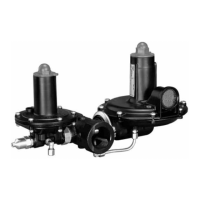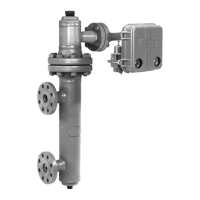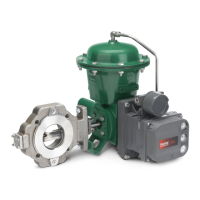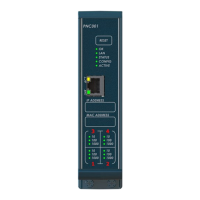Menu 10 Introduction
Parameter
x.00
Parameter
description format
Keypad and
display
Serial
communications
CT Modbus
RTU
PLC Ladder
programming
CTSoft Menu 0
Advanced parameter
descriptions
132 Commander SK Advanced User Guide
www.controltechniques.com Issue Number: 9
Table 10-17 Trip indications
No. String Cause of trip
1 UU*** DC bus under voltage - Low AC supply voltage. Low DC Bus voltage when drive supplied by external DC power supply.
2OU
DC bus over voltage.
Drive voltage rating Instantaneous trip
200V 415V
400V 830V
Excessive inertia in the machine during deceleration. Deceleration rate is set too fast for inertia of machine.
3 OI.AC**
AC instantaneous over current. Insufficient ramp times. Phase to phase or phase to ground short circuit at the drive
output. Autotune required.
4 OI.br** Braking resistor instantaneous current trip. Excessive current in braking resistor. Braking resistor value too small.
6 Et External trip (see Pr 10.32 on page 136)
7O.SPd
Overspeed. Excessive motor speed (typically caused by the mechanical load driving the motor). The drive produces an
overspeed trip if the output frequency (Pr 5.01) exceeds 1.2 x Maximum frequency and regenerating and in current limit.
18 tunE Auto-tune stopped before completion (see Pr 5.12 on page 77)
19 It.br
I
2
t on braking resistor (see Pr 10.31 on page 135)
20 It.AC
I
2
t on drive output current (see Pr 4.15 on page 68)
21 O.ht1 Drive over-heat (IGBT junctions) based on thermal model (see Pr 5.18 on page 80)
22 O.ht2 Drive over-heat based on heatsink temperature (see Pr 7.04 on page 103)
24 th Motor thermistor trip
26 O.Ld1* +24V or Digital output overload
27 O.ht3
Drive over-heat based on thermal model (see Pr 7.35 on page 108)
The drive will attempt to stop the motor before tripping. If the motor does not stop in 10 seconds the drive trips
immediately. Thermal model looks at DC Bus ripple as well as output current. This is to protect the DC Bus stage from
overheating.
28 cL1 Analog input 1 current mode: current loss (see Pr 7.06 on page 104)
30 SCL Serial comms timeout with external keypad on drives comms port
31 EEF
Internal drive EEPROM failure. All the parameters are set to default. The trip can only be removed by entering a load
default command (see Pr 11.43 on page 149)
32 PH
High input voltage phase imbalance or input phase loss. Normally a motor load of between 50 and 100% of drive rating is
required to trigger the trip. The drive will attempt to stop the motor before tripping. The drive looks at DC Bus ripple.
33 rS
Failure to measure stator resistance during auto-tune or when starting in open-loop voltage modes 0 or 3. This is either
because the resistance exceeds the maximum measurable value or no motor connected to drive (see Pr 5.12 on page 77,
Pr 5.14 and Pr 5.17 on page 80)
35 CL.bt Trip initiated from the control word (see Pr 6.42 on page 99)
40-89
t040 -
t089
User trips
90 t090 PLC ladder program attempted divide by zero
91 t091 PLC ladder program attempted access to non-existent parameter
92 t092 PLC ladder program attempted write to a read only parameter
94 t094 PLC ladder program attempted to write a value to a parameter which is out of range
95 t095 PLC ladder program virtual memory stack overflow
96 t096 PLC ladder program invalid operating system call
97 t097 PLC ladder program enabled with no LogicStick inserted or LogicStick removed
98 t098 PLC ladder program invalid instruction
99 t099 PLC ladder program invalid function block argument
100 Drive reset (see Pr 10.38 on page 137)
102 O.ht4 Power module rectifier over temperature. Check for supply imbalance. Increase acceleration/deceleration rates.
183 C.dAt
Data does not exist:
An attempt has been made to transfer data from a blank SmartStick or data block that does not exist or verify after write
fail.
185 C.Acc
SmartStick read/write fail:
The drive cannot communicate with the SmartStick either because it is faulty or is not installed in the drive. Removing a
stick during an access will cause this trip.
186 C.rtg
Rating change:
The parameters loaded to the drive from a SmartStick are for a drive of a different voltage or current rating. No rating
dependent parameters have been transferred.
189 O.cL Overload on current loop input (analog input 1).
199 dESt Destination parameter clash
200 SL.HF
Solutions Module hardware fault. This could occur because the module cannot be identified, or the module has not
indicated it is running within 5s of drive power-up, or an internal hardware fault has occurred in the module.
201 SL.tO
Solutions Module watchdog timeout. The module has started the watchdog system, but has not subsequently serviced the
watchdog within the timeout period.

